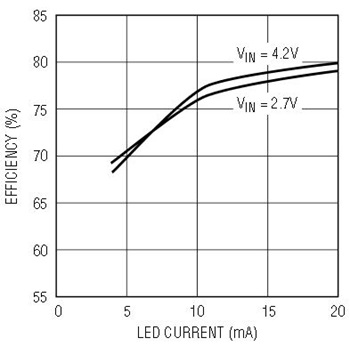Constant-Current DC/DC Converter Drives White LEDs with 80% Efficiency
Introduction
The new LT1932 DC/DC converter is specifically designed to provide high efficiency, constant-current drive for white LED backlights. To achieve the best possible brightness matching, the LT1932 drives the LEDs in a series string, which inherently guarantees current matching and therefore equal brightness among all LEDs in the string. Competing charge-pump designs generate a fixed output voltage and require ballast resistors to set the LED current. Not only is this inefficient, as power is wasted in the resistors, but variations in LED forward voltage cause unequal current flow in the LEDs, leading to brightness mismatch. Typical efficiencies of 75% to 80% are obtained using the LT1932, significantly higher than the 40% to 50% efficiencies obtained in parallel-driven charge-pump solutions.
A single external resistor sets the LED current between 5mA and 40mA, which can then be easily adjusted to provide dimming using either a DC voltage or a pulse-width-modulated (PWM) signal. With an input voltage range of 1V to 10V, the LT1932 works from a variety of input sources; it can even regulate the LED current when the input voltage is higher than the output voltage. The 36V switch rating allows output voltages as high as 35V to be generated, easily driving up to eight white LEDs in series. When the LT1932 is turned off, the LEDs are disconnected from the output, ensuring a true low current shutdown with no excess battery leakage or light output. The 1.2MHz switching frequency allows the use of inexpensive, low profile inductors and capacitors, which, along with the LT1932’s 1mm-tall TSOT-23 package, provide a tiny, low cost LED driver solution. The LT1932’s small size and high efficiency, and its ability to provide uniform brightness, make it an excellent choice for applications using white LEDs to backlight or frontlight color liquid crystal displays (LCDs).
Li-Ion Driver for Four White LEDs
The circuit in Figure 1 is a common choice for many portable devices, driving four white LEDs from a single Li-Ion cell with efficiencies reaching 80%. Figure 2 shows that the efficiency remains high over the full voltage range of the battery and over the entire range of LED current. As shown, dimming is accomplished using a DC voltage, but logic-controlled or PWM-controlled dimming can also be used. Consult the LT1932 data sheet for detailed information on LED dimming. The overall simplicity of the LT1932 solution can easily be seen in Figure 1, as only a few external components are needed to provide a complete LED driver.

Figure 1. Li-Ion driver for four white LEDs.

Figure 2. Efficiency of Figure 1’s circuit.
Li-Ion Driver for Six White LEDs
For bigger displays, more light may be needed to provide adequate backlighting. Capable of driving six white LEDs from a single Li-Ion cell, the circuit in Figure 3 is ideal for LCDs needing a higher level of light output. Efficiency for this circuit, shown in Figure 4, exceeds 77%. Li-Ion systems needing between two and eight LEDs can use similar circuits with efficiencies of 75% to 80%. Consult the LT1932 data sheet for several other LED driver circuits that operate from a single Li-Ion cell.

Figure 3. Li-Ion driver for six white LEDs.

Figure 4. Efficiency of Figure 3’s circuit.
2-Cell Driver for Four White LEDs
The circuit in Figure 5 drives four white LEDs from two alkaline cells, making it a good choice for personal digital assistants (PDAs) and many other handheld instruments with small LCDs. Figure 6 shows the efficiency, which reaches 76%. 2-cell systems that need to drive two, three or five LEDs can use similar circuits (see LT1932 data sheet) with efficiencies reaching 75%.

Figure 5. 2-cell driver for four white LEDs.

Figure 6. Efficiency of Figure 5’s circuit.
Single-Cell Driver for Two White LEDs
For applications that must operate from a single-cell alkaline battery, the circuit in Figure 7 is capable of lighting two white LEDs. Ideal for pagers and many MP3 players, this solution achieves 74% efficiency, as seen in Figure 8. For very small LCDs, the LT1932 can drive a single LED from a single-cell alkaline battery with an efficiency of 72%.

Figure 7. Single-cell driver for two white LEDs.

Figure 8. Efficiency of Figure 7’s circuit.
Conclusion
The constant-current operation of the LT1932 makes it ideal for driving LEDs. The device provides uniform LED brightness at efficiencies up to 80%, making it a significant improvement over charge-pump solutions. With a wide input voltage range and the ability to drive up to eight white LEDs in series, the LT1932 works well in a variety of applications.




















